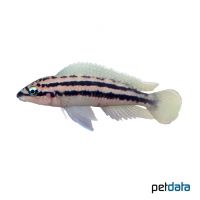Dickfeld's Julie (Julidochromis dickfeldi)
| Dickfeld's Julie Julidochromis dickfeldi | |
|---|---|
| Name | Dickfeld's Julie |
| Name Lat. | Julidochromis dickfeldi |
| Family | Cichlids |
| Family lat. | Cichlidae |
| Order | Cichlids |
| Order lat. | Cichliformes |
| Origin | Lake Tanganyika |
| Habitat | Rocky shore |
| Diet | Omnivore |
| pH | 7.5-9.0 |
| Behavior | Semi-aggressive |
| Keeping | Pair |
| Care Level | Moderate |
| Reproduction | Cave spawner |
| Breeding | Moderately difficult |
| Life Span | 6-8 years |
| Protection | No |
| Metric Units | |
| Size | 8 cm |
| Temperature | 24-28 °C |
| Hardness | 15-18 °dH |
| Aquarium | 80 cm / 110 l |
| US Units | |
| Size | 3" |
| Temperature | 75-82 °F |
| Hardness | 267-320 ppm |
| Aquarium | 30 gal |
Distribution and habitat
The distribution area of the Dickfeld's slender cichlids is exclusively (endemic) the southwestern part of Lake Tanganyika, between Kpamba and Ndole in Zambia. They live in the near shore rock and scree zone between stones, in crevices and caves.
Maintenance
The aquarium setup should have rocky structures reaching the water surface, with plenty of caves, crevices and shelters to provide hiding places, as well as robust plants and some free sand areas.
There should be no detectable ammonia, ammonium or nitrite, and the nitrate level should not exceed 100 mg/l. To ensure the water quality and oxygen content, a filter and heater adapted to the aquarium size is required, as well as lighting for the species-appropriate day-night rhythm of the animals.
Diet
They eat insect larvae and small organisms from the plant cover (growth) of stones. The food supply consists mainly of live food, such as cyclops, daphnia, artemia and black mosquito larvae, which is also accepted in frozen form, supplemented with frozen special food mixtures. In addition, some vegetable food, such as scalded leafy and wild vegetables, algae leaves or high-quality dry food with vegetable components, such as kelp and spirulina
A regular and varied diet promotes health and increases resistance. Only feed as much as is eaten immediately (in a maximum of 10 minutes).
Behaviour and compatibility
They occupy small territories, which they defend vigorously against conspecifics. They should be kept in pairs or better in a group. Keeping several pairs or a group is only recommended in a larger and richly structured tank. They can be well socialized with other small and medium-sized cichlids from Lake Tanganyika
Basically, only compatible fish species with similar demands on water condition and water temperature should be socialized.
Sex dimorphism
The sexes are difficult to distinguish. Males and females are colored the same. Usually the female is slightly larger. With some experience, the sexes can be distinguished by their genital papilla, which in the male is pointed and directed straight back.
Reproduction and breeding
It can take up to a year for a pair to form from a group of fry. They are cave breeders and usually attach the spawn to the cave ceiling or walls. The fry hatch after 2-3 days. The parents hardly perform any brood care, but intensively defend the breeding territory and thus protect their offspring.
Fry must be fed several times a day with special rearing food (Artemia nauplii). Breeding is hardly possible in community tanks, as the fry are easy prey.
Important
The well-being of the fish should be checked regularly. The temperature should be checked daily, the pH, hardness and nitrate value at least every 14 days. A regular partial water change is recommended, even if the pollutant load has not yet reached the upper limit. Sudden changes in water quality should be avoided. Newly introduced fish must be accustomed slowly to the water in the aquarium.
Further literature can be found in your pet store.
References
Text: Werner Winter; Image: petdata
Source: BMELV (1998): Tierschutzgutachten - Haltung von Zierfischen (Süßwasser); RIEHL & BAENSCH (2006): Aquarien Atlas Bd. 1, Mergus Verlag; ENGELMANN (2005): Zootierhaltung - Tiere in menschlicher Obhut: Fische, Verlag Harri Deutsch
- Gemäß § 21 Abs. 5 Tierschutzgesetz idgF
